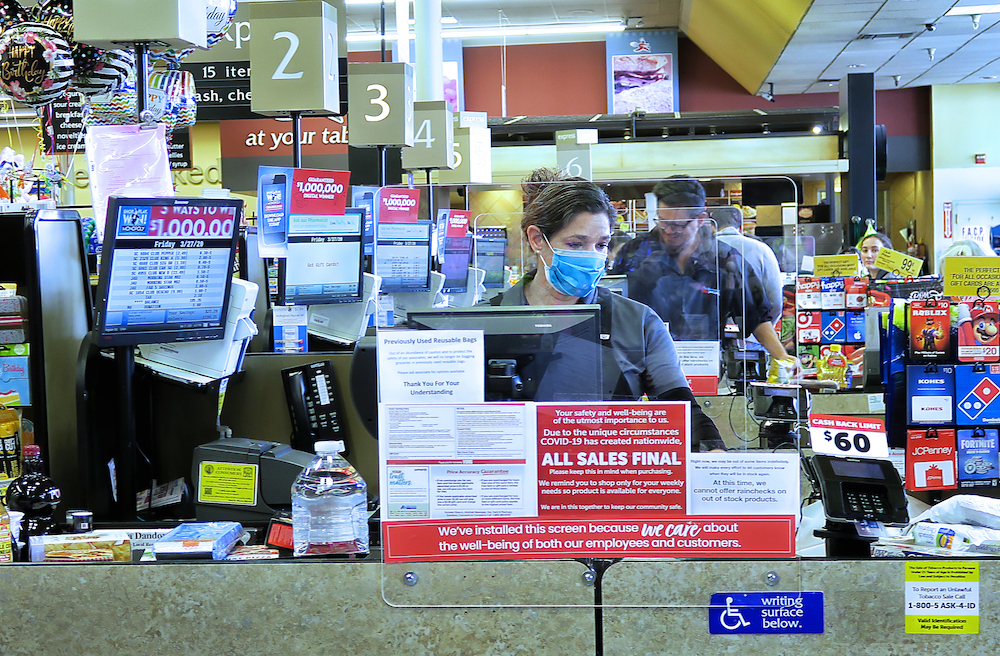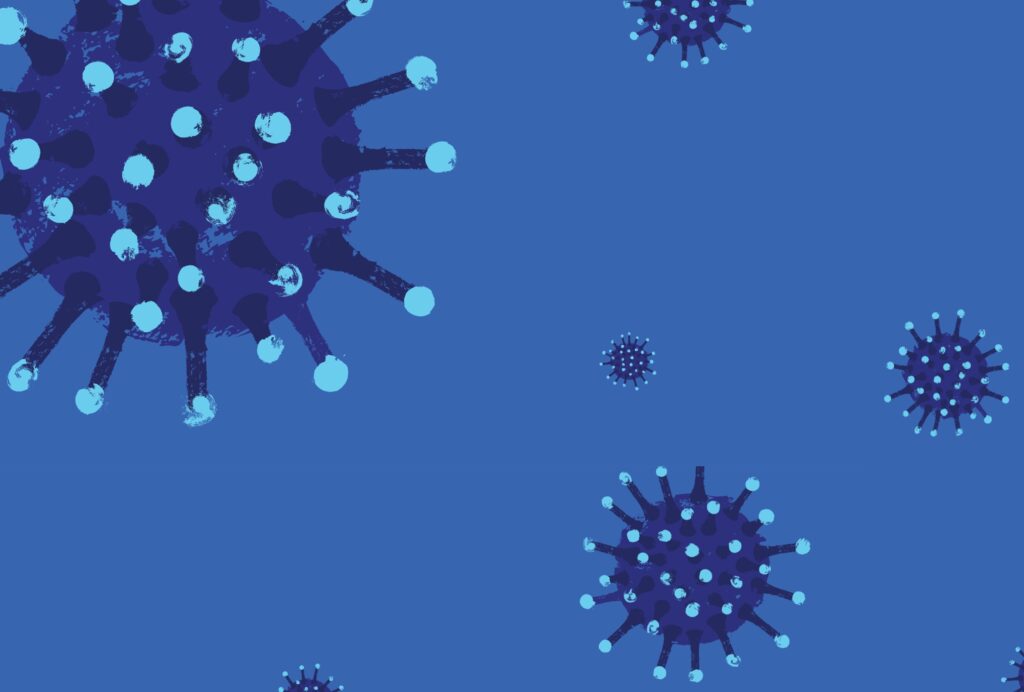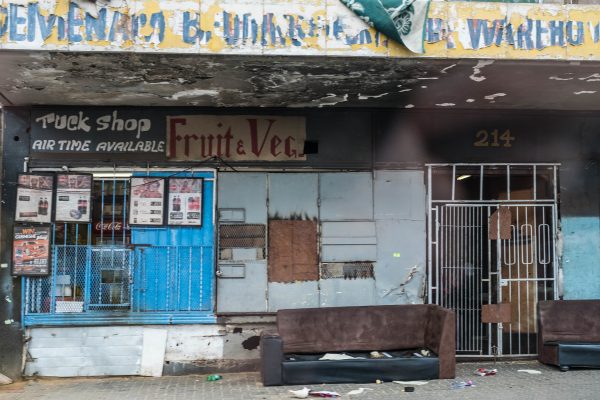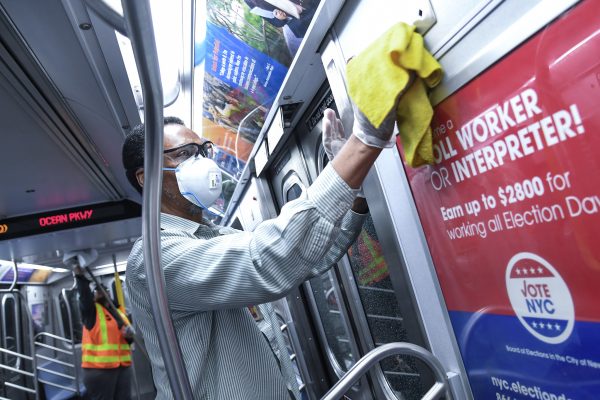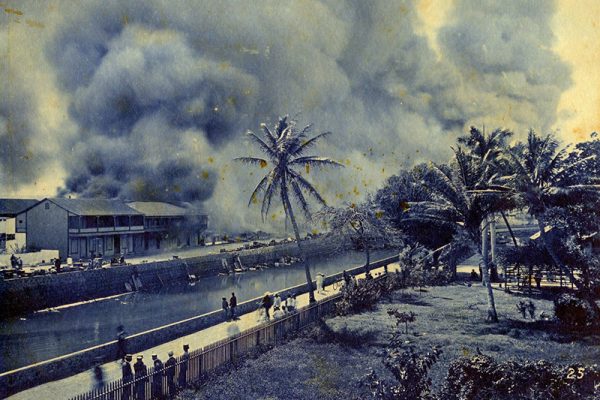A public health emergency does to a society what a stress test does to a bank or the human body: it reveals, among other things, weakness and vulnerabilities that have built up over time. The novel coronavirus, SARS-CoV-2, has done the same for U.S. society through the particular path of its devastation. It serves as a stark reminder of America’s deep, far-reaching economic and race-based inequalities, placing some segments of society in a privileged position while limiting the agency and life prospects of others.
COVID-19 serves as a stark reminder of America’s deep, far-reaching economic and race-based inequalities.
The virus has simply illuminated this reality—again. It remains to be seen whether the crisis it has created lays the groundwork for future political debate, or better yet political changes, that reduce these social and economic inequities. But we will not be able to claim that COVID-19 did not give us the opportunity to reflect on what sort of society we live in, where the gains go, and why they go where they do. We would all wish, of course, that the opportunity had not arrived in this terrible form. Still, the pandemic does provide an occasion for a stock-taking, and perhaps a new politics that helps fix some of what ails us.
• • •
The virus has cut a path of destruction through U.S. society in short order. Infections have soared, as have deaths. The first positive test was reported in Washington state on January 20. As of this writing nearly 1.5 million people have been infected. And, less than three months after the first fatality, the death toll was approaching 90,000, with one health research center, the University of Washington’s Institute for Health Metric and Evaluation (IHME), estimating that it would exceed 135,000 by early August.
Not long after COVID-19 made its appearance in the United States, many hospitals were overwhelmed, ventilators were in short supply, and doctors and nurses worked frenetically to save lives while risking their own because they lacked basic protective gear, such as gloves, gowns, and masks. The layoffs started quickly as well—and accelerated at a breakneck pace. By now 36 million workers have filed for unemployment benefits—nearly twice as many as had in late March and slightly more than a fifth of the entire workforce. At the highpoint, there were more than 6.9 million new jobless claims a week, a tenfold increase over the previous record, 700,000 in 1982. The crashed websites and jammed phones lines at unemployment offices compounded the anxiety experienced by the unemployed.
The unemployment rate, 3.7 percent in February, skyrocketed to 14.7 percent by the end of April, and may well be higher. James Bullard, chair of the St. Louis Federal Reserve Bank, estimates that it could eventually approach 30 percent—something not seen since the Great Depression. The similarities don’t end there. Just like the Great Depression, which evokes images of long lines at soup kitchens, the country’s food pantries have been besieged by hungry people. Photographs showed hundreds—in some cases, thousands—of cars lined up around the nation seeking food aid and other basic household goods. Surveys revealed that in April a fifth of all households, and 40 percent of those containing children under 12, lacked sufficient food.
The growing divisions of U.S. society have an outsize effect in determining who suffers from this pandemic—as well as how the government responds.
Many have excoriated the U.S. government for allowing this to happen in the world’s wealthiest country. Laurie Garrett, the public health expert who sounded the warning early, said that she hadn’t been surprised by the virus’s worldwide rampage or the failure of many countries to curb it, but that the one thing she had not expected was the U.S. government’s inept response. She isn’t alone. The journalist George Packer lamented that the United States had become a “failed state”—a label usually applied to anarchic places like Somalia or Yemen. Surveying the health care system’s response to the pandemic, and the economic devastation that has been made worse by the absence of strong social safety nets to protect the vulnerable, the Nobel Prize–winning economist Joseph Stiglitz likened the U.S. to a “Third World country.”
These labels may be dramatic, but they aren’t hyperbolic. The COVID-19 outbreak reveals an unfortunate, longstanding truth. There are deep, growing divisions in U.S. society, and they have an outsize effect in determining who suffers from this pandemic as well as how the government responds.
• • •
The COVID-19 pandemic reveals just how much inequality can determine the degree to which crises disrupt people’s lives. For starters, the likelihood of catching the disease—and dying from it—depends on a person’s wealth, profession, and race. Households with incomes in the top 20 percent, and people who have college degrees, are most likely to work in the cocoon of the Zoom economy. They can engage in social distancing, while continuing to work from home, while sitting in front of a computer. That means higher-income workers have lower odds of being infected and, importantly, lower odds of being laid off. They also generally have more money saved up for hard times, which enables them to better manage getting sick, losing their jobs, or both.
Many Americans are far less fortunate. They cannot work offsite, nor do their jobs while adhering to social distancing guidelines. Some, such as doctors, are well paid. But tens of millions of others who are at high risk of contracting COVID-19 have incomes well below the national median. Many have service-providing jobs that pay low wages, and some—baristas, servers, hotel staff, people who deliver food from restaurants—rely on tips as an essential supplement. Janitors make an average of $15 an hour. Others with low income who are vulnerable to infection include taxi and bus drivers, grocery store clerks, meatpackers (many of whom are undocumented workers), and fruit and vegetable pickers (another profession where many are undocumented). Those working in one of the hardest hit segments of the U.S. economy—leisure and hospitality and retail sales—make the lowest average wages of all non-farm workers. In short, millions of people who hold a variety of jobs simply can’t afford to stay home and tend to do work that provides a low income. From the start of the pandemic through the end of April—in fewer than three months—16.6 million of these jobs disappeared from 20 economic sectors, nearly half from hospitality and food services and the retail trade.
Low wages are just the start. Many people who hold low-wage jobs also have fewer guaranteed benefits—or none at all. They are less likely to receive paid sick leave or to have health insurance. Households making less than $50,000 are three times less likely to have insurance than those making over $125,000. And people in low-paying jobs are much less likely to have the savings needed to ride out prolonged unemployment. For households that reported savings, the median amount in mid-2018 was $2,000 for those in the bottom quintile of the national income distribution and $10,630 for those in the next highest quintile. That compares to $568,030 for those in the top decile and $1.6 million in those in top 1 percent. According to a Federal Reserve Bank study, 40 percent of working Americans lack rainy day savings to cover an unanticipated expense of $400 (and presumably the unexpected loss of income).
Saying that “we are all in this together” is misleading. It fundamentally ignores the fact that some Americans are “in it” more than others—and need more help.
Another report, by J.P. Morgan Chase, found that 65 percent of working adults lacked the buffer of 6.2 weeks’ worth of after-tax pay to manage a sudden drop in income accompanied by an unanticipated jump in expenses. Moreover, 48 percent did not have readily-available savings totaling 2.6 weeks of net earnings to handle a reduction in income even if they were not faced with unforeseen bills. They would have to borrow the money or fall back on credit cards. Yet, the average emergency room bill was $1,389 in 2017 (an increase of 176 percent since 2007); and average monthly health insurance premiums—if someone has to pay their own way—exceed $600. That may help explain why, in a May 2019 survey, 9 percent stated that they had declared bankruptcy at some point due to medical expenses and 20 percent recalled that a family member had been contacted within the past 12 months by a collection agency because of an unpaid medical bill. And that, mind you, was prior to COVID-19’s arrival. Even when low-income workers have employer-provided health care, they are particularly burdened by the rising cost of deductibles, which averaged $3,500 per individual in 2018—a 150 percent increase within a decade.
Medicaid does help people with low incomes, depending on where they live (in some states Medicaid payments to doctors and hospitals are substantially lower compared to Medicare payments) and the type of care they are seeking (acceptance rates vary depending doctors’ specializations). But the percentage of doctors who accept it varies considerably. Nationally, 70.8 percent of doctors accepted new patients covered by Medicaid versus 89.8 for those relying on Medicare and 90.8 percent for the privately insured.
Unemployment benefits help if you are laid off, but much how it will help depends on your ability to access the benefits and where you live. States’ limits vary considerably. While many states provide 26 weeks of benefits, Arkansas and South Carolina provide 20, Alabama 14 (plus another 5 to those undergoing state-certified job training), Missouri 13, and North Carolina and Florida only 12. That’s three months of support for workers who may have already been out of work since early March. The clock is already ticking for many of those 3 million workers displaced at the very start of the crisis. On top of that, unemployment benefits generally cover less than half of a person’s lost income and total $300 to $400 per week.
Then there’s the $2.2 trillion CARES Act, passed by Congress in March, which provides an extra buffer: 13 additional weeks after workers have reached the maximum duration for unemployment allowed in their state plus; another $600 a week until July 31; $1,200 for individuals with incomes under $75,000; $2,400 for those filing jointly and making less than $150,00; and $500 per child under age 16, for a maximum of $3,400 for households with additional children. But here, too, it’s clear that another check from the federal government won’t be enough to offset the lost incomes—and deeper vulnerabilities—of the country’s most disadvantaged. Much more could have been done. What we got instead was legislation that was weighed down, all too predictably, by a bevy of goodies for the wealthy and politically powerful—the Paycheck Protection Program (PPP), for example.
The PPP has colossally misallocated financial resources. Its $340 billion was meant to help small business (those with 500 or fewer employees) keep workers on the payroll—covering wages and benefits costs for eight weeks—during the crisis. Yet vast sums went to major national name brands instead of the mom-and-pop shops that were promised assistance. Penske Automotive Group and AutoNation, mammoth automobile dealerships, each of which has over $22 billion in revenues and more than 20,000 employees, got funds from the PPP by parsing the program’s language to make the case that individual franchises should be counted as small businesses. Three publicly traded hotel conglomerates—Ashford, Inc., Ashford Hospitality Trust, and Braemar Hotels and Resorts—used the same maneuver, netting a tidy $69 million, never mind that they let go the bulk of their workers or took them off the payroll temporarily, starting in March.
Hospitals in poor and minority neighborhoods are generally less well equipped and also have fewer doctors relative to their population compared to wealthier areas.
Most egregiously, private equity firms, who have the wherewithal to raise money in financial markets, and who are sitting on over $1.5 trillion in capital—this includes the Carlyle Group and Apollo Global Management—received tens of millions of dollars funds from PPP by arguing that the companies they manage were in financial trouble. But those smaller companies acquired by private equity firms were in trouble precisely because they were turned into leveraged assets: the firms took out big loans, using them as collateral. Little wonder that PPP’s well ran dry within two weeks and Congress had to pour in another $300 billion.
Then there’s the $174 billion in temporary tax relief provided for in the CARES Act, which will flow overwhelmingly to wealthy companies and individuals. Companies taking in $25 million or more get extra deductions to ease interest payments on loans. Individuals making $500,000 or more—1 percent of all taxpayers—qualify for big reductions in their capital gains taxes. Those making $1 million or more a year rake in nearly 82 percent of the dollar value of the tax adjustments in an act supposedly aimed at providing relief to businesses, other than corporations, that incurred losses in 2020. And these subsidies are virtually unrestricted: neither individuals nor companies are required to demonstrate that they suffered economic losses as a direct consequence of the pandemic. It’s a not-too-subtle irony considering the title of the act, but hardly an accident given the numerous ways that wealth begets political influence.
• • •
The difficulties facing many of the hardest-hit Americans are aggravated by rising inequality—and its various adverse side effects. Why the pandemic has hit some Americans much harder than others cannot be explained without taking account of the increasingly skewed distribution of wealth in the United States, which has grown massively since the 1970s and now approaches levels unseen since the Roaring Twenties.
Factoring in taxes and benefits provided by the government, the income of the top 1 percent increased by 229 percent between 1979 and 2015 compared to only 46 percent for the bottom 90 percent over the same period. The Pew Research Center reports that the proportion of Americans in the “middle class” decreased from 61 percent to 51 percent between 1971 and 2019. In 1970, middle-income households accounted for 62 percent of the country’s income; by 2018 the proportion had dropped to 43 percent. Lower down the economic ladder, the bottom 10 percent of earners’ share of total income decreased from 10 percent to 9 percent. Most strikingly, over the past four decades, cumulative increase in inflation-adjusted wages for workers in the bottom ten percent increased by all of 1.6 percent. Meanwhile, the share of national wealth in the hands of the top 0.1 percent grew from 7 percent in the 1970s to a remarkable 20 percent in 2017. And, according to study by the Center on Budget and Policy Priorities (CBPP), the increase in the average family income of the top 1 percent between 1979 and 2017 “was nearly five times that of the middle 60 percent and two-and-a-half times that of the bottom fifth.”
How well people weather the economic catastrophe depends substantially on what decile of the income distribution they are in, what level of education they have, what they do for a living—even the color of their skin.
Wealth disparities have follow-on effects that are long lasting, become embedded in society, and reproduce themselves over time. They can determine the quality of individuals’ education, their prospects for social mobility, their income, and even how healthy they are likely to be. The gap in life expectancy between the wealthiest segments of society and the rest has been growing for many years. Men with incomes in the top 20 percent can expect to live 12.7 years longer than those in the bottom 20 percent; for women the difference between the two groups was 13.6 years. The differences were much smaller for those born in 1930—fewer than five years, regardless of gender.
Then there’s the nexus between income and race. Though median household income, taking inflation into account, increased for all racial groups in the United States between 1965 and 2017, minorities haven’t caught up. In 2017 median incomes for whites was $68,145 versus $50,486 for (non-white) Hispanics and 40,258 for blacks. The same pattern holds for the poverty rate: 9 percent of whites are poor versus 19 percent of Hispanics and 22 percent of blacks. (In 2019 the official poverty threshold for a single person 65 years of age or younger was $13,300 and $25,926 for a family of four including two kids.)
Not surprisingly, then, New York City hospitals battling COVID-19 in areas that are poor, and that have a high concentrations of minorities (the two overlap significantly), have been burdened much more by shortages of medical equipment and staff than their counterparts in high-income locales. Minority groups tend to live in areas with more air pollution: those close to refineries, railyards, and automobile repair shops, for example. As a result, they suffer disproportionately from respiratory ailments (such as asthma). That, in turn, increases their risk of dying if they contract COVID-19. Based on a study of 3,000 counties in the United States, researchers at Harvard’s T.H. Chan School of Public Health found that even small variations in the concentration of fine particulate matter make a huge difference in COVID-19 death rates. Infection rates have also been much higher in neighborhoods with a higher population density, where minorities are more likely to be concentrated.
Furthermore, hospitals in poor and minority neighborhoods are generally less well equipped and also have fewer doctors relative to their population compared to wealthier areas. And hospitals and doctors are far more likely to close up shop in poor (urban and rural) areas, where many patients are on Medicare or Medicaid, or lack insurance altogether, in order to chase after the more affluent and privately insured ones. So no one should be shocked by studies reporting that blacks, relative to their proportion of the population in various localities, are substantially overrepresented among COVID-19 hospitalizations. In New York City, the pandemic’s epicenter, people in the bottom 25 percent of the income distribution accounted for 36 percent of all COVID-19 cases compared to 10 percent for the wealthiest 25 percent, and the death rate per thousand for blacks and Hispanics was twice that of whites. New York’s pattern is replicated in other big cities and in states: minorities’ risk of dying once infected by the virus far exceeds that of whites. In Mississippi blacks accounted for 61 percent of COVID-19 deaths—even though they make up only 38 percent of population. In Louisiana the corresponding numbers are 70 and 33 percent, and in Wisconsin, 33 and 7 percent.
Similarly, because they live in communities with overcrowded housing, inadequate health care, and a proportionately greater incidence of diabetes and heart disease, Native Americans are at high risk for infection and death relative to much of the rest of the country. On top of that, at a time when we are reminded repeatedly that the best way to keep the virus at bay is by washing our hands, Native Americans are nine times less likely to have running water at home than households in the rest of the country. They are not alone: nationwide, over 2 million are in the same predicament. For them an essential, elementary precaution that most Americans take for granted represents an ever-present obstacle.
• • •
The moral of this saga is clear: while COVID-19 has swept through the land, it has hit some areas much harder than others. How well people weather the economic catastrophe, and indeed whether they can recover from it at all, depends substantially on what decile of the income distribution they are in, what level of education they have, what they do for a living—even the color of their skin. Meanwhile, politicians call for national unity and civic mindedness, but their rhetoric cannot obscure the deep social and economic divisions in the country, which will ensure that the sacrifices made and the pain endured on account of COVID-19 will, in material terms, not be shared equitably. Thus, saying that “we are all in this together” is misleading. It fundamentally ignores the fact that some Americans are “in it” more than others—and need more help. COVID-19 will divide more than it unites, effectively worsening the disparities that have existed for years.
Even some of the ideas being proposed for the post-crisis economy, such as an even greater reliance on digital technology to provide health care and education, will have consequences that work to the detriment of people who have low incomes and lack a college education. Take Zoom-based college courses. Both of us teach at public universities and can attest that the sudden switch to remote learning in the wake of COVID-19 has created hardships for students who lack a home internet connection or a laptop that is exclusively their own—not surprising considering that half of the students at the City College of New York, where one of us teaches, belong to families with a median income of $40,200. By contrast, students in private colleges and universities hail disproportionately from wealthy families—in just 38 schools, more students come from households with incomes in the top one percent ($630,000 or more) than from those in the bottom 60 percent of public colleges and universities—and would consider having their own computers or high-speed internet service at home as unremarkable.
Will the political order produced by inequality prove so durable that fundamental changes cannot occur, except with the assent of those segments of society that gain the most from the status quo?
Much has already been written about the effects that COVID-19 will have on U.S. politics. In truth, it’s too early to know. Perhaps far-reaching political changes will occur that end the decades-long demonization of the state and the characterization of social programs to reduce inequality as schemes to foster servitude and dependence and to promote class warfare. Policies dedicated to reducing inequality and protecting those most exposed to economic crises emerged in the 1930s and the 1960s, in part because continued political stability required them. Will we see another such phase? Or will the political order produced by inequality prove so durable that fundamental changes cannot occur, except with the assent of those segments of society that gain the most from the status quo—and which therefore have every reason to preserve it, and abundant means with which to do so? We will not know until COVID-19 has tendered its final bill, which, let us hope, isn’t unpayable for the millions of Americans living paycheck to paycheck.
Of this much we can be sure: social and economic crises, no matter how severe, cannot in themselves transform, or even substantially change, the political order, which plays a substantial role in determining who suffers the most from such upheavals, to what degree, and why. As many commentators have shown—including Jacob Hacker and Paul Pierson, Larry Bartels, Martin Gilens and Benjamin Page, and Marty Jezer and Ellen Miller (among others)—our politics, in particular how public funds are spent, in what amounts, for what purpose, and for whose benefit, are shaped substantially by the power wielded by money.
That will not change unless outcomes in elections and movements that mobilize popular support reduce the power that dollars (especially from mega-donors, corporate Political Action Committees, Dark Money, and lobbyists) have in determining who has the most political access to, and influence over, politicians, and hence the greatest ability to shape the content and priorities of the political agenda, legislation, and governmental policies. The current rules of the game—especially after the Supreme Court’s rulings in Citizens United v. Federal Election Commission (2010) and McCutcheon v. Federal Election Commission (2014)—make that an uphill battle.
Then there are the deep ideological divisions within the United States, which is more polarized than at any time in recent memory, a reality reflected even in how the pandemic is reported in the media. Moreover, the divisions are not confined to bread-and-butter issues—something progressives tend to forget, or at least downplay, in discussions about how best to appeal to voters who cast their lot with Donald Trump in 2016. Absent success on the political front, after this pandemic we will merely pick up the wreckage and move on—along the same path.
